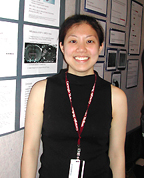
| T H E N I H C A T A L Y S T | M A Y – J U N E 2004 |
|
|
|
POSTBAC POSTERS CARRY THE DAY IN MAY |
by
Aarthi Ashok and Javier Lorenzo |
More than 200 postbaccalaureate trainees opened their research projects to the scrutimy of the rest of the NIH community at the fifth annual Postbac Poster Day, May 5.
Postbacs are recent college graduates with an interest in biomedical research who were selected to spend a year or two in training at NIH to find out whether the life of a research scientist actually suits them. The great majority apply to (and are accepted into) a Ph.D. program and/or medical school during their stay at NIH. (More postbac posters will appear in the next Catalyst.)
 |
|
Cindy Yang
|
Cindy
Yang, Carnegie Mellon University, Pittsburgh, Pa.: Iron Misregulation
Leads to Neurodegeneration in Mice
Preceptor: Tracey
Rouault, NICHD, Cell
Biology and Metabolism Branch
Yang’s research focused on iron imbalance as a cause of neurotoxicity. She worked with two mouse models of abnormal iron metabolism—one in which mice overexpress transferrin receptor, the receptor that escorts iron into cells, and the other in which there is loss of the IRP family of proteins, which are post-transcriptional regulators of ferritin and other iron-metabolism genes.
Mice that overexpress transferrin receptor performed poorly on behavioral and motor testing. These mice were prone to seizures and tremors and had a thinning coat; the males died within six months.
The second model had only one copy of IRP1 and lacked both copies of IRP2. These mice had a movement disorder and displayed large amounts of iron in the substantia nigra and the cerebellum, two regions of the brain involved in movement and coordination.
Yang hopes her research will add to the knowledge of such conditions as Parkinson’s and Alzheimer’s diseases. She’ll continue her neuroscience studies in a doctoral program at the University of California at San Francisco beginning this fall.
—Javier Lorenzo
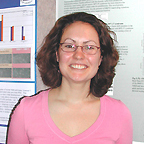 |
|
Wynne Morgan
|
Wynne
Morgan, Colorado College, Colorado Springs: Drosophila melanogaster
as a Model for Hyperparathyroidism—Jaw Tumor Syndrome
Preceptors: Jianhua
Zhang and William
Simonds, NIDDK, Metabolic
Diseases Branch
Hyperparathyroidism–jaw tumor syndrome (HPT-JT) is an autosomal dominant disease characterized by benign and malignant parathyroid tumors, fibrous jaw tumors, and renal lesions. Previous work on HPT-JT uncovered mutations in HRPT2, a gene that codes for the protein parafibromin, whose function is not known. That the mutations in HPT-JT families inactivate HRPT2, however, suggests a tumor-suppressor function for parafibromin.
Morgan studied the HRPT2 counterpart in the fly, which, she said, has a surprising 63 percent homology to the human gene. Through a series of removals and reinsertions of the gene, she found that eliminating both copies does not damage the fly in its earlier larval stages but is lethal prior to the adult stage. She next hopes to rescue the phenotype by restoring the gene. She hopes, too, that her research will help elucidate the tumor-suppressor function of HRPT2.
—Javier Lorenzo
Quynh
Nguyen, Philadelphia University, Philadelphia, PA: mTOR Cellular
Localization
Preceptors: Beverly
Mock and Valery
Bliskovsky, NCI-CCR, Laboratory
of Genetics
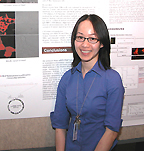 |
|
Quyhn Nguyen
|
Mouse plasmacytoma is a model for human lymphomas and myelomas. Plasmacytomas can be induced by peritoneal injections of prostane. A few mouse strains (including BALB/c mice) are genetically susceptible to this type of cancer; most others (including the DBA strain) are resistant. The goal of the project of which this study is a part is to understand how the genes responsible for susceptibility or resistance to cancer work.
In earlier work, it was found that tumorigenesis was controlled by several genes. FRAP/mTOR (mammalian target of rapamycin) was identified by positional cloning strategies as the most likely candidate for one of these genes. Comparison of nucleotide sequences revealed that the FRAP gene from susceptible and resistant mice differed by a single amino acid substitution. Of note, the amino acid present in resistant mice was conserved for about 1.3 billion years. Functional analysis revealed that the FRAP protein from the susceptible strain was less efficient as a kinase, consistent with the hypothesis that FRAP functions as a tumor suppressor.
Nguyen transfected cell cultures with fluorescently tagged versions of the two allelic variants of FRAP. She showed that while the allelic version of FRAP from resistant DBA mice localized specifically in the cytoplasm, the variant from susceptible BALB mice was distributed evenly throughout the cell. The cellular distribution of the mutated form was comparable to that of a nonfunctional truncated form of FRAP–providing a clue, Nguyen said, to the mechanism that impairs the tumor-suppressor activity of FRAP in the susceptible mice.
—Aarthi Ashok
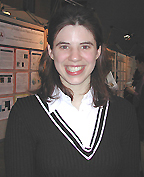 |
|
Erica Sutton
|
Erica
Sutton, McGill University, Montreal: Truth-Telling and the Turner Syndrome
Preceptor: Barbara Biesecker,
NHGRI, Social and Behavioral Research
Branch
Turner syndrome (TS) is a sex chromosome abnormality caused by partial or full deletion of one sex chromosome. It affects 1 in 2,500 women and confers short stature and, often, infertility.
Sutton worked on a project that ascertained the life concerns of women affected with TS and the effect of learning of their condition by adolescence vs. not knowing anything about it until they sought help because they could not become pregnant.
The researchers questioned a cohort of 97 girls and women about the disclosure of their condition by a parent or a health-care provider. Those who had been told the truth by one or the other had more confidence in their ability to deal with the repercussions of the condition. They were better able to incorporate infertility into their self-identity at a younger age.
One-third of participants had learned of their infertility serendipitously from a stranger; they reported subsequent mistrust of family members and providers.
Sutton hopes the study will help to more fully elucidate the physician-patient relationship and its effect on health outcomes. Personally, she intends to pursue her interests in reproductive ethics and genetic counseling in graduate school.
—Javier Lorenzo
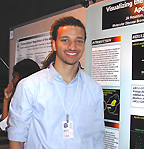 |
|
John Allen Houston
|
John
Allen Houston, Stanford University, Stanford, Calif. Intracellular trafficking
of Apolipoprotein A1
Preceptors: Silvia
Santamarina-Fojo, H. Bryan
Brewer, and Edward
Neufeld, NHLBI, Molecular
Disease Branch
The ABCA1 transporter protein is essential for the removal of excess cholesterol (LDL) from peripheral cells such as macrophages, where accumulation of cholesterol can lead to arterial closing.
ABCA1 transfers intracellular cholesterol to the extracellular apolipoprotein A1 (apoA1) to form HDL particles that in turn transfer cholesterol to the liver, where it’s removed from the body as bile. The critical interaction of ABCA1 and apoA1 has been thought to occur at the cell surface.
Work from the Molecular Disease Branch (J. Biol. Chem. 279:15571–15578, 2004) suggests, however, that this interaction may actually occur intracellularly. These researchers observed rapid endocytosis of labeled apoA1 in human fibroblasts transfected with ABCA1-GFP, and significant co-localization of these proteins occurred within late endosomes.
Their current model suggests that ABCA1 is present both in late endosomes and at the cell surface and that following endocytosis of apoA1, interaction of these proteins occurs in late endosomes with subsequent trafficking of lipidated apoA1 to the cell surface.
As a step towards defining a therapeutic strategy for Tangier’s disease, a condition characterized by low HDL levels due to a nonfunctional ABCA1, Houston examined the effect of delivering ABCA1-GFP to Tangier’s disease patients’ fibroblasts in vitro.
Expression of ABCA1-GFP led to a marked decrease in the amount of intracellular cholesterol in Tangier patients’ cells, as assessed by cytochemical staining of cholesterol with filipin. "This rescue of an in vitro phenotype may lead the way for future gene therapy," Houston said.
—Aarthi Ashok
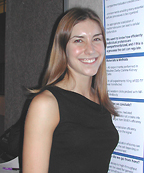 |
|
Corinna Levine
|
Corinna
Levine, Cornell University, Ithaca, N.Y.: How Efficiently Do Cells Compartmentalize
Proteins?
Preceptor: Manu
Hegde, NICHD, Cell
Biology and Metabolism Branch
The aim of this study was to determine the efficiency of compartmentalization of signal sequence-bearing secretory proteins using a sensitive luciferase reporter assay in MDCK cells. The results were surprising, Levine said, in that the efficiency ranged widely between 60 and 95 percent, depending on the particular signal sequence.
Levine and her colleagues also found that the degree of confluency, or cell density, influenced the efficiency of protein compartmentalization. In the case of osteopontin, increased confluency was associated with increased localization in the cytoplasm and decreased localization in the endoplasmic reticulum.
This finding, Levine said, suggests that cells can modulate the levels of secretory proteins available in the cytoplasm in response to the environment–a significant finding in light of the fact that differential compartmentalization of several secretory and membrane proteins is being linked to disease states.
"There is a big impetus to understand the parameters that control the accumulation of proteins, such as prion protein, in the cytoplasm," she said. She hopes that future work leads to the design of novel therapeutic drugs that could change the balance of proteins in different cellular compartments in such conditions as prion diseases.
—Aarthi Ashok
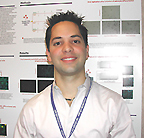 |
|
Frank Diaz
|
Frank
Diaz, Tufts University, Boston: Initiation of Glial Differentiation from
Human CNS Progenitor Cells Promotes JC Virus Susceptibility
Preceptor: Eugene
Major, NINDS, Molecular
Virology and Neurogenetics Section
Diaz’s work stems from the establishment of a unique cell-culture system that uses specific growth factors to induce selective differentiation of human CNS progenitor cells into populations of astrocytes or neurons.
Using this system, Diaz has started to ask questions about cellular determinants of susceptibility to infection by a neurotropic polyomavirus, JC virus (JCV), the etiological agent of progressive multifocal leukoencephalopathy.
JCV infects CNS progenitors at low levels and mature astrocytes robustly, whereas neurons are completely resistant. Infection of progenitor cells with JCV and subsequent differentiation showed that cells became susceptible to JCV infection within three days of differentiation towards an astrocytic lineage, as measured by viral DNA replication and viral late gene expression.
"It is too early to tell whether stem cells in the brain may be targets of JCV infection," Diaz said, although these results implicate molecular factors expressed early during glial cell differentiation in regulating JCV susceptibility.
According to Diaz, this work suggests that JCV susceptibility is likely governed by intracellular factors, rather than cell surface interactions. In previous work in the lab, differential expression of a transcription factor, NF1-D, was observed in mature glial cells and neurons. Future work, Diaz said, will determine whether NF1-D also confers susceptibility to JCV infection in astrocytic progenitors.
—Aarthi Ashok
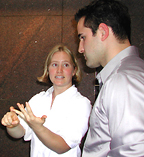 |
|
Bridget Lynch explains her findings to postbac Matthew
Crescenzo, whose own poster on "PET Imaging of Phosphodiesterase-4
with (C-11) Rolipram (NIMH Molecular
Imaging Branch, Robert
Innis, Masahiro
Fujita) was also on display
|
Bridget Lynch, Gustavus Adolphus College, St. Peter, Minn.: Protein Characterization of Stage-Specific Ovarian Cancer Biomarkers via Mass Spectrometry Preceptor: Mark Lowenthal, NCI-CCR, Laboratory of Pathology
Diagnosis of ovarian cancer at stage 3, now possible with CA-125 peptide, is generally too late to intervene to improve outcome. Lowenthal’s laboratory has been seeking biomarkers to detect ovarian cancer at stages early enough to intervene in a meaningful way. The lab has achieved a high degree of specificity in detecting early-stage ovarian cancer using a mathematical model based on the mass spectra profile of patient serum.
Concentrating on low-abundance proteins that bind to albumin, Lynch analyzed serum proteins by mass spectroscopy and uncovered 586 proteins not known to exist in serum. By sequencing samples from different patient populations, she also found that the concentrations of specific subsets of proteins vary between stage-specific cohorts.
This fall, Lynch will attend the University of New Mexico School of Medicine in Albuquerque and plans to become a family physician.
—Javier Lorenzo